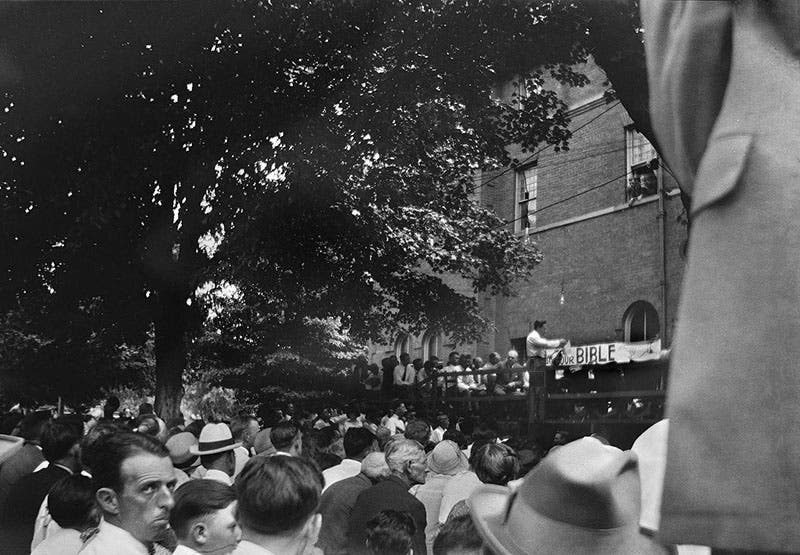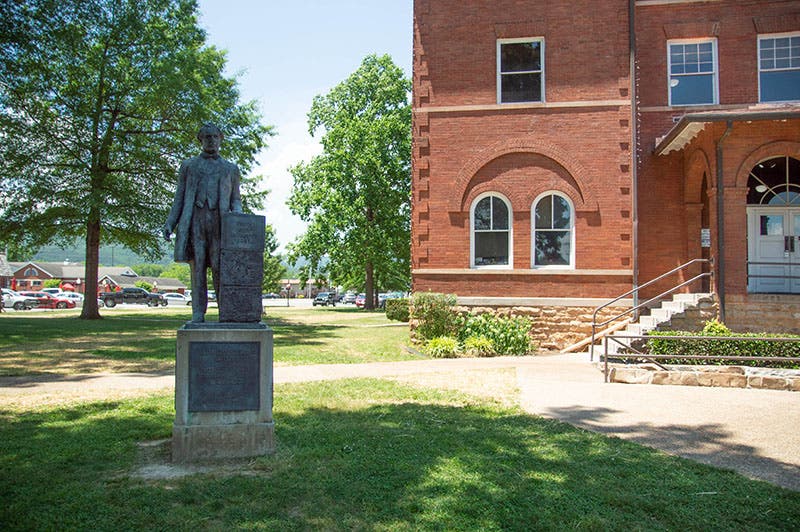Scientist of the Day - William Jennings Bryan
On July 20, 1925, prosecuting attorney William Jennings Bryan took the stand as a witness in the famous Scopes trial. The trial was in its ninth day, having begun on July 10, at the Rhea County courthouse in Dayton, Tennessee. John Scopes, a high school biology teacher, had been charged with violating the Butler Act, which forbade the teaching of evolution in Tennessee schools. Bryan, a renowned political figure, who had twice run unsuccessfully for U.S. President, had volunteered his services as special prosecutor, since he was a passionate fundamentalist Christian.
The examiner that day was the noted defense attorney Clarence Darrow, who had been brought in by the American Civil Liberties Union (ACLU), a relatively new organization that had virtually taken over the defense of Scopes. Darrow was almost as famous as Bryan, a defense attorney who had, the previous year, successfully kept the self-confessed killers Leopold and Loeb off death row, arguing that they were mentally incapacitated and too young to be executed.
The Scopes trial had been relatively uneventful in its first eight days, with the defense forbidden to call its array of expert witnesses on evolution, since evolution was not, supposedly, on trial. The most dramatic moment had come on the 5th day of the trial, when Bryan had waved around an evolutionary textbook, George Hunter’s Civic Biology (1914), and protested that a diagram in the book included circles for mammals, fish, even insects, but no special circle for “Man.” We showed that diagram in our post on Scopes.
It was a surprise when Bryan volunteered to be cross-examined by Darrow on the Bible, on which Bryan considered himself an expert. It was so hot that day that the cross-examination was moved outside, to a platform on the courthouse lawn. Before the cross-examination, Darrow had objected to a sign hanging on the platform, which read “Read your Bible,” and the sign was removed. In a photograph by William Silverman, a 19-year-old college student, one can see the sign before its removal (second image). This is one of a packet of Scopes trial photos that only recently came to light and were acquired by the Smithsonian Institution in 2010.
During the cross-examination, Darrow and Bryan engaged in a lengthy give-and-take discussion about how to read the Bible. For quite some time Bryan, was able to maintain that the Bible means just what it says, claiming, in response to Darrow’s questions, that a big fish really did swallow Jonah, and that Joshua really did make the sun stand still. But finally, Bryan confessed that a day of Creation might not have been a 24-hour day, but rather an entire Age, and with this admission that the Bible could not always be taken literally, Darrow had found a chink in Bryan's armor. But he was not able to exploit it as he wished before the proceedings ended for the day, never to be resumed. We show here two photographs of the outdoor cross-examination, one by Watson Davis (first image), and one taken from the crowd by Silverman (third image).
Bryan did not come off well in some of the exchanges, with his continual confessions that he himself had never inquired about the origins of humans or civilizations or the age of the earth, being quite content not to know, and the press, especially H.L. Mencken, had a field day at Bryan's expense. In truth, if one reads the transcript, there was no clear winner that day, and Bryan was not the buffoon he was made out to be by Mencken, or as he was portrayed in the film Inherit the Wind (1960), where he was played by Frederic March (with Spencer Tracy as Darrow). But it didn't make much difference. The entire exchange was stricken from the court record the next day, and Scopes was found guilty. And five days after that, Bryan died of a heart attack, with the Scopes Trial now his final legacy. It was an unfortunate ending for the Great Commoner.
A statue honoring Bryan was erected on the courthouse lawn in Dayton in 2005, where they have always appreciated Bryan’s role in their famous trial (fourth image, above). He had the lawn pretty much to himself until recently (2018), when a statue of Darrow was put in place some distance away. It is too bad they are not facing each other, so they could re-enact their famous confrontation in bronze.
Dr. William B. Ashworth, Jr., Consultant for the History of Science, Linda Hall Library and Associate Professor emeritus, Department of History, University of Missouri-Kansas City. Comments or corrections are welcome; please direct to ashworthw@umkc.edu.









